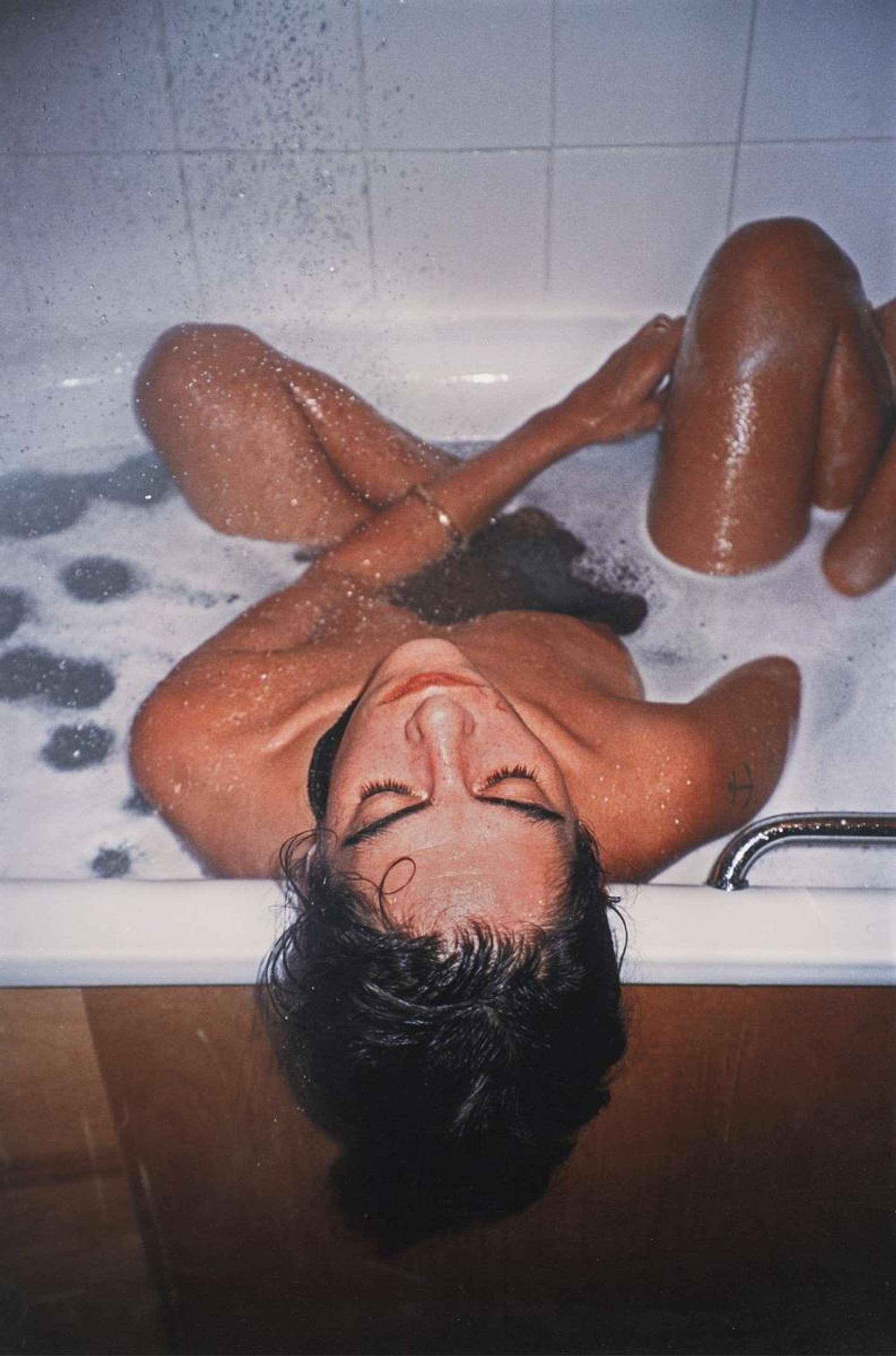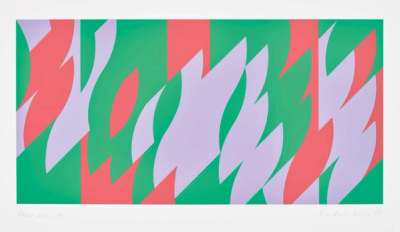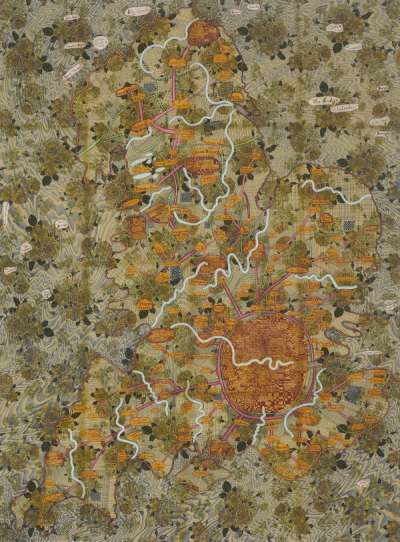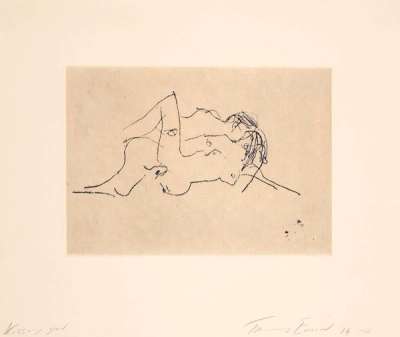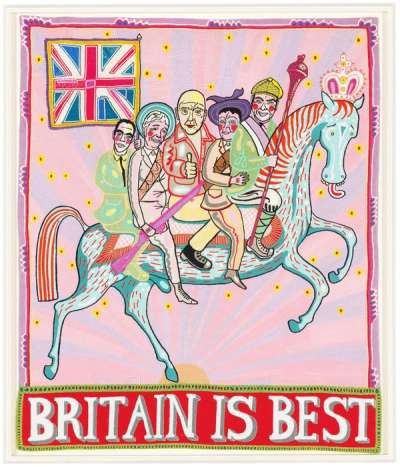Modern British Art & National Identity

 Britain Is Best © Grayson Perry 2014
Britain Is Best © Grayson Perry 2014Live TradingFloor
The 20th and 21st centuries have witnessed a surge of interest in Modern British Art, with artists exploring themes and techniques that reflect the evolving nature of national culture and heritage. The British art scene is diverse and dynamic, supported by a thriving market, passionate collectors, and world-class galleries and museums. From L. S. Lowry to Damien Hirst, British artists are a formidable force to be reckoned with; their artwork reflecting the essence of Britishness in the modern age.
What Defines British Art?
In art historical discourse, British Art is often considered an outlier when studying the evolution of Modern European Art. Where our European neighbours were more preoccupied by religious iconography and art patronised by institutions like the Church, British Art has always had a distinct ‘otherness‘ in art history - with unique movements from the Pre-Raphealites to the Young British Artists (YBAs). Perhaps it is because we are an island, perhaps it is because we have a culture rather detached from the rest of Europe (a truth long before Brexit), or perhaps it is because British national identity is so intertwined with other cultures. However, there is a complexity and singularity to British Art, as artists throughout history have navigated what it means to be British and worked to establish a distinctly British visual culture.
Institutions such as Tate, the V&A, the Royal Academy of Arts, and the National Gallery all showcase the breadth of artistic talent in this country. Though London is indeed the locus of British Art, galleries and museums across the country are proof in point that art is an integral part of British culture and heritage in its many forms and iterations.
Here are some of the key British Artists who have shaped and reflected ‘Britishness’ in the modern era, and the movements they cultivated:
L. S. Lowry: Capturing the Essence of British Identity Through Industrial Landscapes & Everyday Life
Laurence Stephen Lowry (1887-1976) is a quintessential British artist, celebrated for his paintings of industrial landscapes and working-class life in the North of England. Lowry's unique style, with its matchstick figures and crowded scenes, offers a powerful and authentic representation of a particular aspect of British history. His colour palette is specifically reminiscent of the industrial smog that shrouded Britain since the Industrial Revolution, focusing on the monochrome of urban landscapes. His work captures the spirit of the nation's industrial past and present, while offering a poignant reflection on the human experience within it.
Lowry & The Beautiful Game: A British Preoccupation with Football
Not only did Lowry champion the working-class ‘everyman’ of the industrial North, he also depicted Britain's most popular sport: football. Lowry's Going To The Match, for example, depicts fans wandering around The Bolton Wanderers football club in Burnden Park. The works speaks to both Lowry's own position as an ardent admirers of the game, and also the British nature of the pastime. As with the majority of Lowry's oeuvre, Going To The Match speaks to a quintessentially British culture.
It is for this reason that Lowry's art has become highly coveted and valued especially by collectors based in the UK. Lowry's artwork has a close association with the North of England, and he remains one of the nation's most beloved artists. In 2022, there was uproar when one of his works about football went on sale for a record price at Christie’s. Fears that the work would be removed from public view prompted a successful campaign to raise funds to acquire the painting for the general public, illustrating just how significant his contribution has been to British identity.
Bridget Riley: The Optics of British Cultural Identity
Bridget Riley (born 1931) is a pioneer of the Op Art movement, which explores optical illusions and the perception of movement in art. Her work is characterised by bold, geometric patterns that create a sense of movement and vibration on a flat canvas. Riley represents a dynamic force in modern art, pushing the boundaries of perception and questioning the nature of the visual experience. Her innovative style was impactful in Britain and beyond, and eventually became associated with the Mod subculture of the 1960s, and played a crucial role in the cultural phenomenon that was the British Invasion during the Swinging Sixties.
One of her seminal works, Gala (1974), exemplifies her bold visual experimentation. By exploring vibrant colours to mimic the dynamic flow of a rippling prismatic surface, Gala stands as a pinnacle of the Op Art movement. This iconic piece gained renewed attention during the 2022 Modern British Art Evening Sale at Christie’s London, where it significantly exceeded its estimated value of £3.5 million, selling for an impressive £4.4 million and setting a new auction record for Riley.
The fluidity of her work speaks to the ever-evolving nature of identity and creativity, and she has remained venerated within the art world. Her work is often shown at national institutions such as Tate and the Southbank Centre, attracting local and global audiences alike. Having recently achieved record sales prices, her popularity shows no signs of waning and she has established herself as one of the leading lights of Modern British Art.
David Hockney: The British Pop Art Landscape
David Hockney (born 1937) is a versatile artist known for his paintings, printmaking, photography, and stage design. He rose to prominence as a key figure of the British Pop Art movement in the 1960s. Hockney's work often incorporates elements of British culture and landscape, making him an important figure in the exploration of national identity through art. His vibrant, colourful style and willingness to experiment with new techniques demonstrate the dynamic nature of Modern British Art.
Hockney has continuously grown in the market, and in 2018 was briefly the most expensive living artist. His work is popular among collectors and institutions alike, illustrating how his popularity has endured since the 1960s. Hockney truly tailored the Pop Art movement for a British audience, and has pronounced Britain's position in the art world throughout his trailblazing career.
Harland Miller: Reimagining British Identity through Satire
Harland Miller (born 1964) is a British painter and writer known for his large-scale, satirical paintings based on the covers of Penguin classic books. Miller's work playfully explores British literary culture and its role in shaping national identity, as well as nods to his native York. His witty, ironic and provocative reinterpretations of book covers invite viewers to reconsider their assumptions about Britishness, while engaging with the nation's rich cultural heritage.
Miller’s work also invites the viewer to consider the relationships between “high” and “low” art, questioning the difference between a painter and a book-cover illustrator and pondering on the parallels between art and the written word. Though Miller's style has been imitated by many, his works have a distinct grittiness: a true testament to the Brit's love of irony and satire.
Damien Hirst: Embodying a Young British Artist
Damien Hirst (born 1965) is a leading figure of the Young British Artists (YBA) movement that emerged in the 1990s. His work and advocacy have helped shape and define the Modern British Contemporary art scene, with their fresh and entrepreneurial approach to their practice. Hirst's provocative and controversial works, such as preserved animals in formaldehyde and intricate displays of pharmaceutical pills, confront themes of mortality, consumerism, and the human condition. His work forces a dialogue about British society and its values, challenging the status quo and pushing the boundaries of what is considered art. His work often fetches top prices in the market and is exhibited internationally, placing him as one of the most influential artists in the world.
 Image © Tate / Recumbent Figure © Henry Moore 1938
Image © Tate / Recumbent Figure © Henry Moore 1938Henry Moore: Sculpting Britishness
Henry Moore (1898-1986) was a prominent sculptor whose large-scale, abstract works transformed public art in the 20th century in Britain. A graduate of the Royal College of Art, he was one of the first British artists to become globally famous. Moore's sculptures are now iconic symbols of British aesthetic and identity, often being inspired by the human shape, prehistoric forms and natural landscape. His commitment to creating accessible public art has had a lasting impact on the national scene, fostering a sense of shared cultural heritage and pride.
To this day, art remains very much part of the British public cultural sphere, with charities such as ArtFund helping keep art free and accessible for all. The strong desire to preserve Moore's public sculptures speaks to their significance in Post-War history and culture, and their enduring role in British visual culture.
Tracey Emin: Challenging the Stiff Upper Lip
Tracey Emin (born 1963) is another influential member of the YBA movement, known for her deeply personal and confessional artworks. Emin's work often addresses themes of love, loss, and sexuality, inviting viewers to engage with intimate aspects of the human experience. Her pieces – such as the infamous My Bed installation – challenge conventional notions of art and blur the lines between public and private, while her neon works contrast a highly visible medium with her innermost thoughts. Emin's bold, unapologetic approach to art reflects a spirit of defiance and self-expression, which is often at odds with the British cultural norms of propriety.
Through her vulnerability, Emin challenges the idea of the “stiff upper lip”, encouraging emotional and personal conversations between her art and the viewer. This has reflected positively on her market value, with buyers appreciating a glimpse into the artist’s psyche.
The Future of British Art
Modern British Art has played a pivotal role in shaping and reflecting the nation's identity, with artists like L. S. Lowry, Bridget Riley, David Hockney, Harland Miller, Damien Hirst, Henry Moore, and Tracey Emin offering unique insights into the evolving nature of British society. The future of British art is promising, with a new generation of artists exploring themes of national identity, politics, and society in innovative ways.
As the United Kingdom navigates the complexities of the modern world and the consequences of Brexit, artists will continue to push boundaries and question conventional notions of what it means to be British. With the support of a vibrant art market, galleries, and museums, British art will maintain its significant role in shaping and reflecting the nation's identity.




